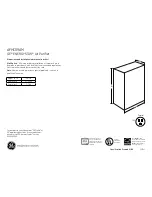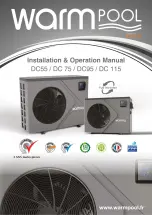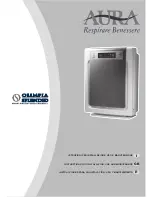
9
Charging the Unit in AC mode
If the outdoor temperature is 65 degrees F or higher:
After completing the refrigerant line connections, leak
checking the system, and evacuating the indoor section
and all line connections (using proper methods), perform
the following steps:
1. Determine the recommended charge addition (if applicable)
for the system being installed. This information is in the
unit’s QRD (Quick Reference Data sheet).
2. Calculate the amount of additional refrigerant needed for
the line set length of the actual installation. This information
is on the first page of the unit’s QRD (Quick Reference
Data sheet).
3. Weigh in the additional charge amounts determined by
step 1 and 2 above.
4. Adjust the charge to match the superheat (for fixed orifice
systems) or subcooling (for TXV systems). There are three
different resources for doing this:
a.) The chargecalculator.com website. This will walk
you through the charging process step by step.
b.) The charging tables on the inside of the outdoor
unit’s electrical box cover panel. These tables
provide superheat targets for fixed orifice systems
and subcooling targets for TXV systems. The system
should be charged so that the measured superheat/
subcooling are within 1 degree F of the target listed
in the table.
For fixed orifice systems:
• If your measured superheat at the suction valve is
LESS THAN
the recommended superheat value
in the table then
REMOVE
refrigerant.
• If your measured superheat at the suction valve
is
GREATER THAN
the recommended superheat
value in the table then
ADD
refrigerant.
For TXV systems:
• If your measured subcooling at the liquid valve is
LESS THAN
the recommended subcooling value
in the table then
ADD
refrigerant.
• If your measured subcooling at the liquid valve is
GREATER THAN
the recommended subcooling
value in the table then
REMOVE
refrigerant.
c.) The charging tables in the Supplemental Charging
Information, can be found online in the literature
library. The tables can also be accessed by scanning
the QR code on the unit’s electrical panel. The
pressures listed in these tables are for reference only
and are to be used in troubleshooting a system. The
system should be charged to match the superheat
or subcooling targets as previously noted and not
to match the system pressures. Follow the same
procedure described in 4b above.
If the outdoor temperature is between 35 degrees F and
65 degrees F:
After completing the refrigerant line connections, leak
checking the system, and evacuating the indoor section
and all line connections (using proper methods), perform
the following steps:
1. Determine the recommended charge addition (if applicable)
for the system being installed. This information is in the
unit’s QRD (Quick Reference Data sheet).
2. Calculate the amount of additional refrigerant needed for
the line set length of the actual installation. This information
is on the first page of the unit’s QRD (Quick Reference
Data sheet).
3. Weigh in the additional charge amounts determined by
step 1 and 2 above.
4. Block off the discharge of the outdoor fan.
NOTE:
One half
of the unit should be covered corner to corner as shown
5. With the unit in cooling mode, Adjust the charge to match
the superheat (for fixed orifice systems) or subcooling (for
TXV systems). There are two different resources for doing
this:
a.) The chargecalculator.com website. This will walk
you through the charging process step by step.
b.) The low ambient charging tables on the inside of
the outdoor unit’s electrical box cover panel. These
tables provide superheat targets for fixed orifice
systems and subcooling targets for TXV systems.
The system should be charged so that the measured
superheat/subcooling are within 1 degree F of the
target listed in the table.
For fixed orifice systems:
• If your measured superheat at the suction valve is
LESS THAN
the recommended superheat value
in the table then
REMOVE
refrigerant.
• If your measured superheat at the suction valve
is
GREATER THAN
the recommended superheat
value in the table then
ADD
refrigerant.
For TXV systems:
• If your measured subcooling at the liquid valve is
LESS THAN
the recommended subcooling value
in the table then
ADD
refrigerant.
• If your measured subcooling at the liquid valve is
GREATER THAN
the recommended subcooling
value in the table then
REMOVE
refrigerant
NOTE
: One half of the unit should be covered corner to corner.
Figure 4. Blocked Off Outdoor Fan Discharge






























